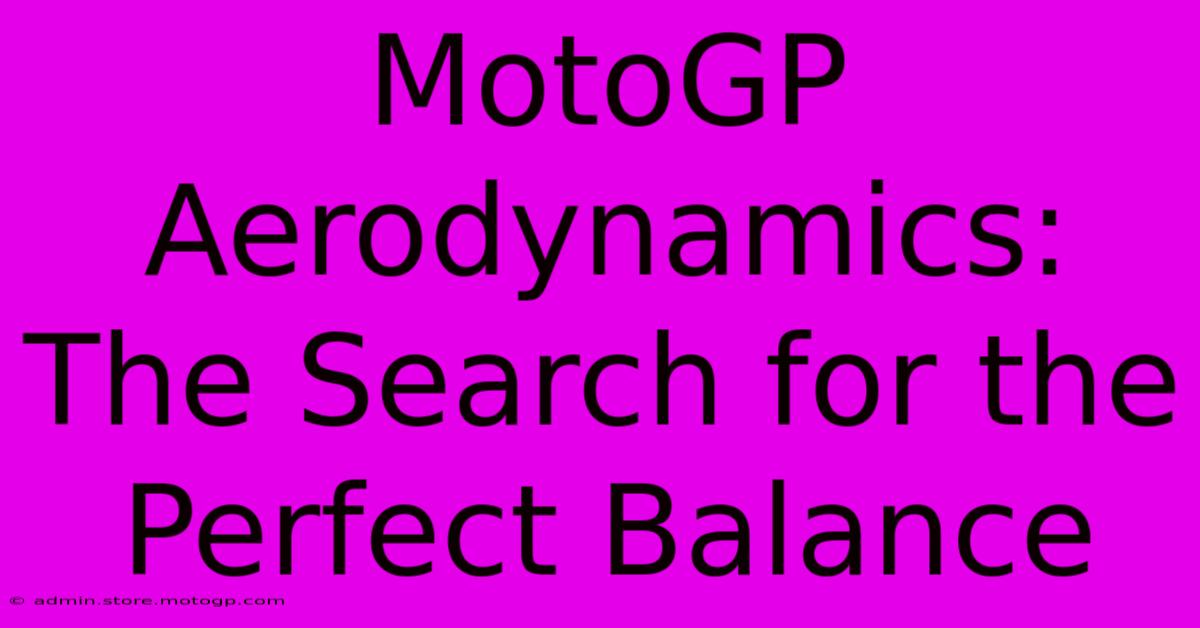MotoGP Aerodynamics: The Search For The Perfect Balance

Table of Contents
MotoGP Aerodynamics: The Search for the Perfect Balance
MotoGP racing is a relentless pursuit of speed and precision. Every millisecond shaved off lap times can mean the difference between victory and defeat. While rider skill and engine power are crucial, a significant factor often overlooked is aerodynamics. The quest for the perfect aerodynamic balance is a constant battle for MotoGP teams, a complex interplay of downforce, drag, and stability.
Understanding the Aerodynamic Challenge
MotoGP bikes, unlike their road-going counterparts, operate at extreme speeds and lean angles. This creates unique aerodynamic challenges. At high speeds, air resistance (drag) becomes a significant impediment, slowing the bike down. Conversely, downforce – the force pushing the bike towards the track – is essential for stability at high lean angles and cornering speeds. The goal? To maximize downforce while minimizing drag. This seemingly simple objective requires incredibly sophisticated engineering and constant refinement.
The Role of Winglets and Fairings
Modern MotoGP bikes are heavily sculpted, incorporating various aerodynamic aids designed to manipulate airflow. Winglets, small wing-like appendages, are perhaps the most visible example. They generate downforce, pushing the front of the bike down, improving stability during braking and cornering. However, poorly designed winglets can increase drag, negating their benefits.
The fairings, the bodywork enveloping the engine and chassis, are meticulously shaped to manage airflow around the bike. These are not just cosmetic; they are designed to channel air smoothly, reducing drag and directing airflow to optimize downforce and cooling. Even minor changes to the fairing's shape can have a significant impact on performance.
The Constant Evolution of MotoGP Aerodynamics
The aerodynamic landscape of MotoGP is constantly evolving. Regulations often change, forcing teams to rethink their designs. Furthermore, the relentless pursuit of marginal gains pushes engineers to explore increasingly sophisticated solutions. Computational Fluid Dynamics (CFD) plays a crucial role, allowing teams to simulate airflow around the bike virtually, testing different designs before building physical prototypes.
Wind Tunnel Testing: The Ultimate Validation
While CFD provides valuable insights, wind tunnel testing is the ultimate validation. Here, engineers place scale models or even full-sized bikes in a controlled airflow environment, measuring the effects of different aerodynamic elements. Data gathered from wind tunnel tests helps fine-tune designs, ensuring that theoretical improvements translate into real-world performance gains.
The Human Factor: Rider Input and Adaptation
Aerodynamics isn't just about the machine; it's about the interaction between the machine and the rider. A bike with exceptional aerodynamic performance might be difficult to control, negating its advantages. Rider feedback is invaluable in the development process, helping engineers find the optimal balance between downforce, drag, and rider comfort. The rider's ability to adapt to the bike's aerodynamic characteristics is just as crucial as the bike's inherent aerodynamic efficiency.
The Future of MotoGP Aerodynamics
The future of MotoGP aerodynamics promises further innovation. We can expect to see continued refinement of existing technologies, as well as the exploration of new concepts. This could include the use of active aerodynamic elements, which can adjust their shape and function depending on the track conditions and speed.
In Conclusion:
The pursuit of the perfect aerodynamic balance in MotoGP is an ongoing arms race. It's a fascinating blend of science, engineering, and rider skill. The constant quest for marginal gains ensures that MotoGP remains at the cutting edge of motorsport technology, pushing the boundaries of what's possible. The intricate dance between downforce, drag, and rider feedback is what truly makes MotoGP aerodynamics a captivating and crucial element of the sport.

Thank you for visiting our website wich cover about MotoGP Aerodynamics: The Search For The Perfect Balance. We hope the information provided has been useful to you. Feel free to contact us if you have any questions or need further assistance. See you next time and dont miss to bookmark.
Featured Posts
-
Your Go To Guide For Racing On Tv Today
Feb 18, 2025
-
Tnt Sports Your Essential Moto Gp Guide
Feb 18, 2025
-
The Legacy Of American Moto Gp Legends
Feb 18, 2025
-
Understanding Moto 2 Specs A Beginners Guide
Feb 18, 2025
-
F1 Austin Get Closer To The Action
Feb 18, 2025
